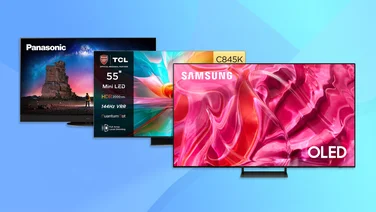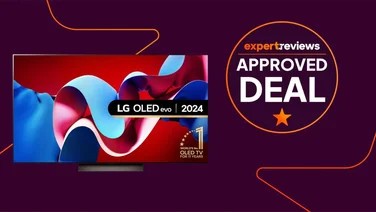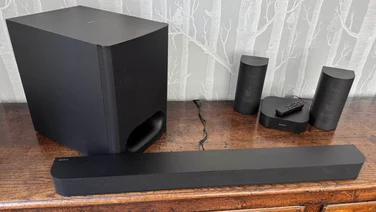To help us provide you with free impartial advice, we may earn a commission if you buy through links on our site. Learn more

Philips has revealed the pricing and availability of its hotly anticipated flagship Ambilight OLED TV, the Philips OLED+908, at a TP Vision event in Barcelona on 13 September.
The OLED+908, which uses an advanced META OLED panel and has an integrated sound system designed and tuned by Bowers & Wilkins, will go on sale in mid-October, and its three screen sizes come with price tags to match their impressive specs. The 55in model will set you back £2,999, with the 65in and 77in options costing £3,499 and £4,999, respectively. At present, Richer Sounds is the only confirmed retailer in the UK.
I was at the event in Spain and got to see the OLED+908 up against two of its biggest competitors: the LG G3 and Samsung S95C. Picture quality was impressive, though I was only shown a handful of clips in the TV’s Crystal Clear picture mode and there was no opportunity to hear the B&W sound system in action. It’s too early to make any definitive judgments, but the Philips OLED+908 is certainly looking like a premium television to be reckoned with.
Philips OLED+908: Key specifications
- Panel type: OLED (with Micro Lens Array)
- Resolution: 4K (3,840 x 2,160)
- Refresh rate: 120Hz
- Processor: P5 (7th-gen)
- Ambilight: Three-sided
- HDMI inputs: 2 x HDMI 2.1, 2 x HDMI 2.0
- Sound system: Integrated 3.1-channel (81W)
- Operating system: Google TV
Philips OLED+908 preview: Features
The OLED+908 is powered by Philips’ seventh-generation P5 AI processor and has an OLED panel that uses Micro Lens Array (MLA) technology and a META Booster algorithm to hit stated peak brightness of 2,100 nits on a 3% window and up to 250 nits on a full-field pattern.
That’s incredibly bright for an OLED but its use of the aforementioned technologies helps improve performance in a number of other ways, too. MLA increases viewing angles by up to 30% compared with conventional OLED panels, while META Booster enhances colour expression as brightness levels fluctuate.

The OLED+908’s panel also benefits from a new polariser referred to as Vanta Black. This seeks to reduce reflections and, based on my time gawping at the TV, does so remarkably well.
Furthermore, the OLED+908 incorporates three features to push picture quality even higher: “Super Resolution”, “Smart Bit Enhancement” and “Ambient Intelligence V2”. Super Resolution uses depth mapping to deliver increased detail and sharper edges; Smart Bit Enhancement elevates 8-bit content to something closer to 14-bit, removing banding and smoothing gradation, and Ambient Intelligence V2 uses the television’s built-in RGB Colour Sensor to adjust the picture settings to compensate for both sunlight and room lighting.
Dolby Vision 4K 120Hz is supported when hooked up to a compatible console via either of the two HDMI 2.1 inputs and there are a further two HDMI 2.0b ports for connecting external devices. Variable Refresh Rate (VRR) is present and correct, with both FreeSync Premium and Nvidia G-Sync supported. There doesn’t seem to be a dedicated gaming hub akin to Samsung’s Game Bar 3.0 but there are picture and audio modes specifically tailored for gaming.

One thing that sets Philips TVs apart is their incorporation of Ambilight. The OLED+908 has responsive LEDs built into the back of three sides of its panel (the top, left and right edges) and these illuminate the wall behind the TV to help increase immersion and reduce eye strain.
On the audio front, Philips has once again partnered with esteemed British manufacturer Bowers & Wilkins and the OLED+908 incorporates an integrated 3.1-channel 81W sound system. This consists of a 75mm bass woofer and four bass radiators on the rear of the set and left, right and centre channels built into what looks like a slender soundbar that runs below the panel. Each channel comprises a pair of 30mm mid-range drivers and a 19mm dome tweeter. Both Dolby Atmos and DTS:X are supported and there’s the option to connect an external subwoofer should you require more potent bass reproduction.
Like its predecessor, the OLED+907, the OLED+908 runs the Google TV operating system and supports the HDR10, HDR10+, Dolby Vision and HLG HDR formats. It’s good to see that Philips has also done some work on the user interface, too, reducing the space menus take up on the screen and grouping and ordering settings in a more logical manner.
READ NEXT: The best TVs for gaming
Philips OLED+908: Initial impressions
The Philips OLED+908 is a great-looking TV, both in terms of its aesthetics and the pictures it produces. It has a sensible stand that allows it to be swivelled on its axis, and the Kvadrat-covered B&W sound system adds a touch of class to the overall package. Its searing brightness delivered highly impressive detail and contrast in the scenes I watched, and images looked vivid, well-defined and punchy.
Given the highly controlled environment in which the TV was showcased, I’m wary of reading too much into the side-by-sides with the LG G3 and Samsung S95C. However, based on a few clips in its Crystal Clear mode, it looks set to give that five-star pair a run for their money and even surpass them in some key areas.
To my eyes, the OLED+908 was able to depict finer details in bright areas more cleanly and its motion handling was smoother than that of its competitors while watching a fast-paced clip of cyclists. The white point also looked more appropriately judged, particularly when compared with the S95C, which had an obvious blue tint. Colours on the S95C did look more saturated in some scenes, however – one of the advantages of the quantum dot filter used in its QD-OLED panel.
There’s lots to like here. Reflections appeared to be noticeably reduced compared with the 2022 model, and the new UI promises to be a big improvement on the old one. I particularly love the redesigned remote, which can be recharged via USB-C, has a backlight that illuminates when picked up, along with a clever mechanism via which number buttons are hidden until you press the remote’s central button, leaving the zapper a lot less cluttered but no less functional.

While I can’t speak for how well it utilises Ambilight, how good its B&W system sounds, nor how accurate it is in Filmmaker mode, what I saw of the Philips OLED+908 was very encouraging. And, when it comes to features, it offers just about everything you could ask for from a premium TV. Just how good it is is something only thorough testing will reveal, however, and we hope to receive a review unit and have a full review published soon.
If you can’t wait until then, you’re spoilt for choice when it comes to high-end OLED tellies. LG, Panasonic, Samsung and Sony all have options that’ll set you back a small fortune and are capable of taking your home entertainment experience to a whole new level.
Those options are listed below, along with the prices of each of their screen sizes, though it’s worth bearing in mind some of them have already seen discounts from what they cost at launch.
- 55in: £2,000 | Buy now from LG
- 65in: £2,700 | Buy now from LG
- 77in: £4,300 | Buy now from LG
- 83in: £6,000 | Buy now from LG
Panasonic MZ2000
- 55in: £2,700 | Buy now from John Lewis
- 65in: £3,600 | Buy now from John Lewis
- 77in: £4,500 | Buy now from John Lewis
- 55in: £1,579 | Buy now from Amazon
- 65in: £2,299 | Buy now from Amazon
- 77in: £3,199 | Buy now from Amazon
Sony A95L
- 55in: £2,999 | Buy now from Sony
- 65in: £3,699 | Buy now from Sony
- 77in: £5,999 | Buy now from Sony
If you’re after something a little less spendy, you may want to keep an eye out for the Philips OLED808, the follow-up to last year’s Philips OLED807, which received a five-star rating and our Recommended badge.
Philips has confirmed that five screen sizes – 42in (£1,400), 48in (£1,600), 55in (£1,800), 65in (£2,100) and 77in (£3,800) – will be released in the UK in mid-October. The OLED808 makes do without a B&W sound system and instead has a 2.1-channel system, which is capable of outputting 50W on the 42in model and 70W on the larger sizes.
The 55in variant and above use an OLED EX panel, while the smallest option packs a basic OLED screen that’s unable to hit the same levels of brightness as its siblings. Otherwise, the OLED808 has a lot in common with the OLED+908. It’s powered by the same processor, has a three-sided Ambilight, two HDMI 2.1 ports, and runs the Google TV OS.






